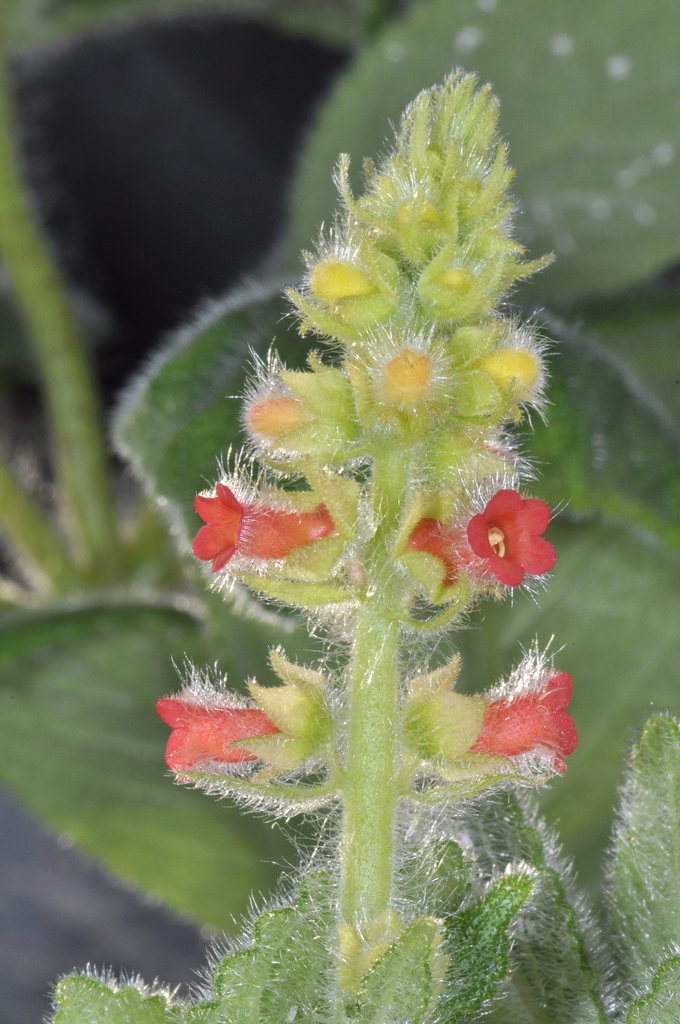Brazilian Violet
(Sinningia curtiflora)

Description
Sinningia curtiflora is a species of flowering plant in the family Gesneriaceae, native to Brazil. It is commonly known as the Brazilian Violet or the Lipstick Plant, due to its striking red flowers that resemble a tube of lipstick. This article will provide a comprehensive guide to Sinningia curtiflora, including its appearance, habitat, cultivation, and uses. Description: Sinningia curtiflora is a herbaceous perennial plant that grows up to 1 meter in height. Its leaves are glossy, green, and oval-shaped, measuring approximately 10 cm in length and 6 cm in width. The plant's flowers are the most striking feature, with long, tubular, and bright red blooms that grow in clusters on the top of the stem. The flowers have a yellowish throat and are about 3 cm in length. Sinningia curtiflora blooms in the summer and autumn months, attracting pollinators such as hummingbirds and butterflies. Habitat: Brazilian Violet is native to Brazil and can be found growing in the humid forests of the Mata Atlântica biome, at altitudes ranging from 100 to 1,500 meters. The plant is adapted to growing in the understory of the forest, where it receives dappled sunlight and consistent moisture. In the wild, Sinningia curtiflora grows in a well-drained soil that is rich in organic matter. Cultivation: Sinningia curtiflora is a relatively easy plant to cultivate and can be grown indoors or outdoors, depending on the climate. The plant prefers a warm and humid environment, with temperatures ranging between 18-24°C. It can tolerate lower temperatures for short periods, but prolonged exposure to cold can damage the plant. If growing Sinningia curtiflora indoors, it should be placed in a bright location that receives dappled sunlight. The plant should be watered regularly, but care should be taken not to overwater it, as this can lead to root rot. It is best to allow the soil to dry out slightly between waterings. Fertilizer can be applied every two weeks during the growing season to promote healthy growth. If growing Brazilian Violet outdoors, it should be planted in a well-drained soil that is rich in organic matter. The plant should be placed in a partially shaded location, as direct sunlight can scorch the leaves. Watering should be consistent, but care should be taken not to waterlog the soil. Propagation: Sinningia curtiflora can be propagated from stem cuttings or by dividing the plant's rhizomes. Stem cuttings should be taken in the spring or early summer, and the cutting should be approximately 10 cm in length. The cutting should be dipped in rooting hormone and planted in a well-drained soil mix. The soil should be kept moist, and the cutting should be kept in a bright, warm location until it has established roots. To propagate Brazilian Violet by dividing the rhizomes, the plant should be lifted from the soil and the rhizomes should be carefully separated. Each division should have at least one healthy stem and a portion of the root system. The divided plant can be replanted in a well-drained soil mix, and the soil should be kept moist until the plant has established itself. Uses Sinningia curtiflora is primarily grown as an ornamental plant, due to its striking red flowers and attractive foliage. The plant can be grown in pots or containers and placed in indoor or outdoor settings. Its bright flowers make it an ideal plant for adding color to gardens, patios, and balconies. In addition to its ornamental value, Sinningia curtiflora has also been used in traditional medicine to treat various ailments, such as respiratory infections, fever, and inflammation. The plant contains a variety of compounds, including flavonoids and alkaloids, which have been found to have antimicrobial and anti-inflammatory properties. However, it should be noted that the medicinal uses of Brazilian Violet have not been extensively studied, and caution should be taken when using the plant for medicinal purposes. It is always best to consult with a healthcare professional before using any plant for medicinal purposes. Conservation Status The conservation status of Sinningia curtiflora is currently listed as "Vulnerable" on the International Union for Conservation of Nature (IUCN) Red List. This is due to habitat loss and degradation as a result of deforestation and urbanization, as well as over-collection for horticultural purposes. The plant is endemic to Brazil, and its natural habitat is the Mata Atlântica biome, which has been significantly reduced in size and is highly fragmented. The remaining forest fragments are under threat from logging, mining, and agricultural activities. Efforts are being made to conserve Sinningia curtiflora and its habitat. These include the establishment of protected areas and the implementation of sustainable land-use practices. In addition, there are initiatives to raise awareness about the plant's conservation status and to encourage its cultivation as a horticultural crop, which can reduce pressure on wild populations.
Taxonomic tree:







